Strategic Analysis of Sandlands Vineyards
VerifiedAdded on 2023/06/04
|10
|2399
|261
AI Summary
This report emphasises on strategic analysis of Sandlands Vineyards in the U.S. wine market taking into consideration segmentation, consumer change, competitive response, and prioritisation of limited resources. Sandlands Vineyards should capitalise on working with small old vineyards that most people avoid. Sandlands Vineyards should concentrate on the production of two common types of wines: red and white wine. Sandlands should employ blockchain as a disruptive game changer in the wine industry.
Contribute Materials
Your contribution can guide someone’s learning journey. Share your
documents today.
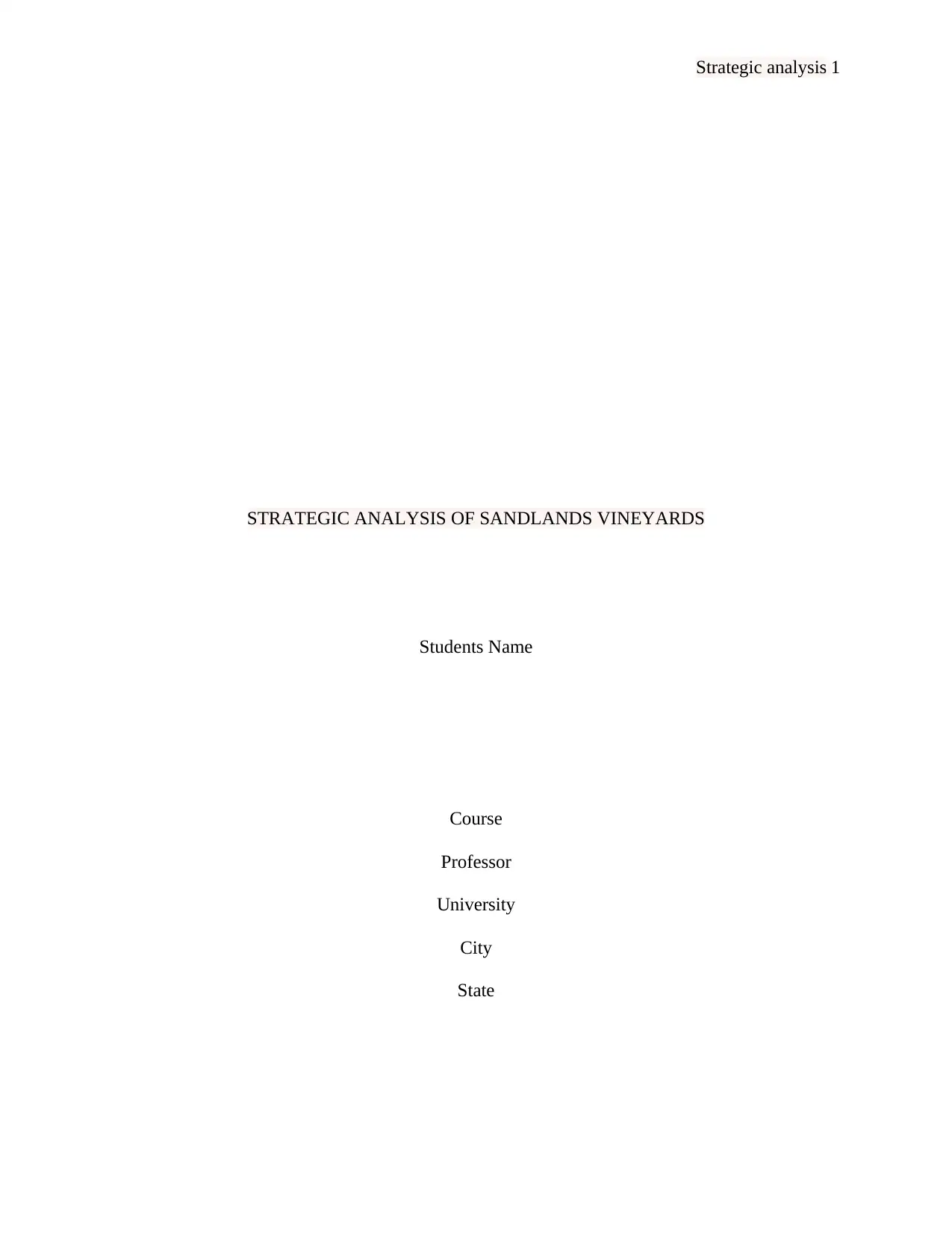
Strategic analysis 1
STRATEGIC ANALYSIS OF SANDLANDS VINEYARDS
Students Name
Course
Professor
University
City
State
STRATEGIC ANALYSIS OF SANDLANDS VINEYARDS
Students Name
Course
Professor
University
City
State
Secure Best Marks with AI Grader
Need help grading? Try our AI Grader for instant feedback on your assignments.
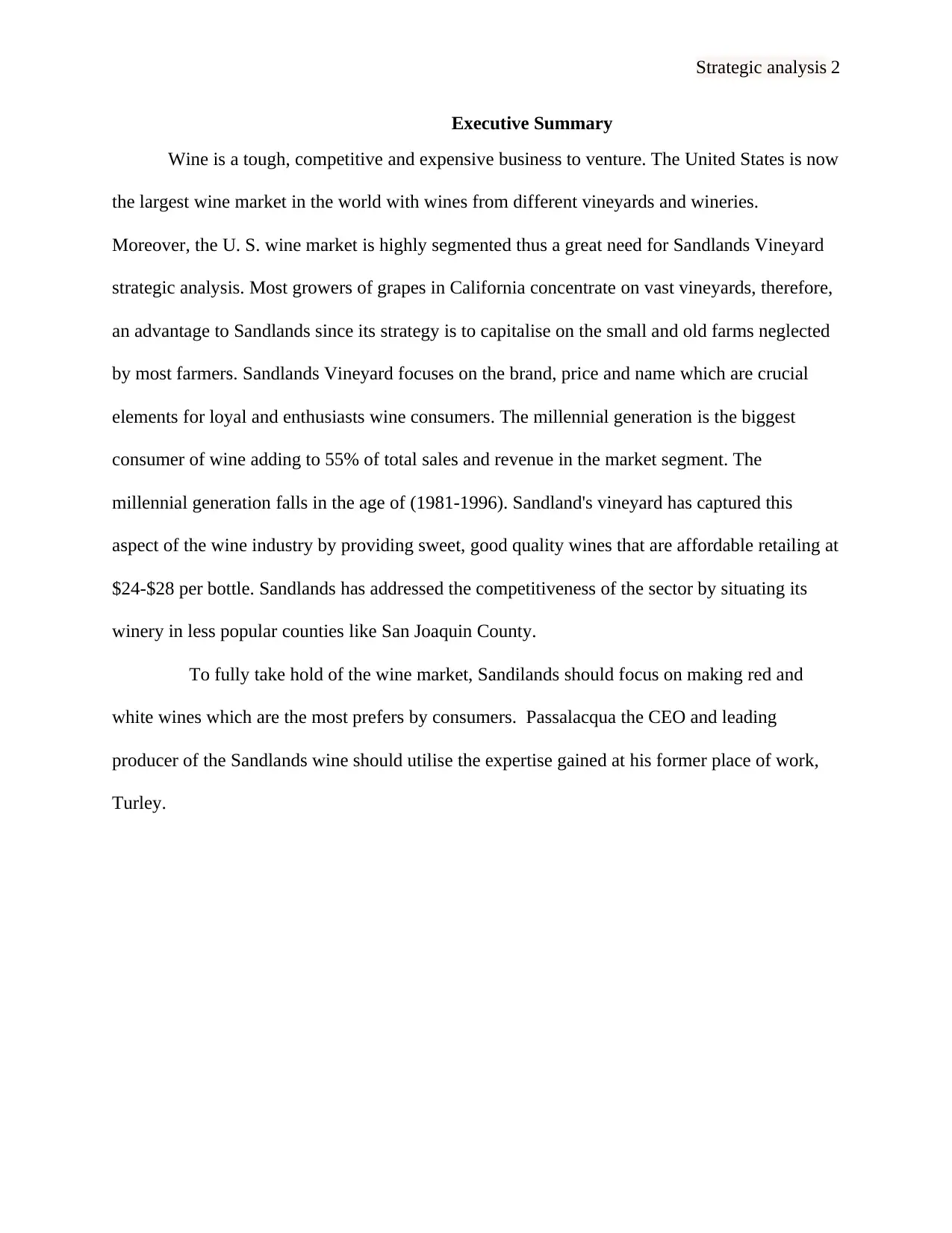
Strategic analysis 2
Executive Summary
Wine is a tough, competitive and expensive business to venture. The United States is now
the largest wine market in the world with wines from different vineyards and wineries.
Moreover, the U. S. wine market is highly segmented thus a great need for Sandlands Vineyard
strategic analysis. Most growers of grapes in California concentrate on vast vineyards, therefore,
an advantage to Sandlands since its strategy is to capitalise on the small and old farms neglected
by most farmers. Sandlands Vineyard focuses on the brand, price and name which are crucial
elements for loyal and enthusiasts wine consumers. The millennial generation is the biggest
consumer of wine adding to 55% of total sales and revenue in the market segment. The
millennial generation falls in the age of (1981-1996). Sandland's vineyard has captured this
aspect of the wine industry by providing sweet, good quality wines that are affordable retailing at
$24-$28 per bottle. Sandlands has addressed the competitiveness of the sector by situating its
winery in less popular counties like San Joaquin County.
To fully take hold of the wine market, Sandilands should focus on making red and
white wines which are the most prefers by consumers. Passalacqua the CEO and leading
producer of the Sandlands wine should utilise the expertise gained at his former place of work,
Turley.
Executive Summary
Wine is a tough, competitive and expensive business to venture. The United States is now
the largest wine market in the world with wines from different vineyards and wineries.
Moreover, the U. S. wine market is highly segmented thus a great need for Sandlands Vineyard
strategic analysis. Most growers of grapes in California concentrate on vast vineyards, therefore,
an advantage to Sandlands since its strategy is to capitalise on the small and old farms neglected
by most farmers. Sandlands Vineyard focuses on the brand, price and name which are crucial
elements for loyal and enthusiasts wine consumers. The millennial generation is the biggest
consumer of wine adding to 55% of total sales and revenue in the market segment. The
millennial generation falls in the age of (1981-1996). Sandland's vineyard has captured this
aspect of the wine industry by providing sweet, good quality wines that are affordable retailing at
$24-$28 per bottle. Sandlands has addressed the competitiveness of the sector by situating its
winery in less popular counties like San Joaquin County.
To fully take hold of the wine market, Sandilands should focus on making red and
white wines which are the most prefers by consumers. Passalacqua the CEO and leading
producer of the Sandlands wine should utilise the expertise gained at his former place of work,
Turley.
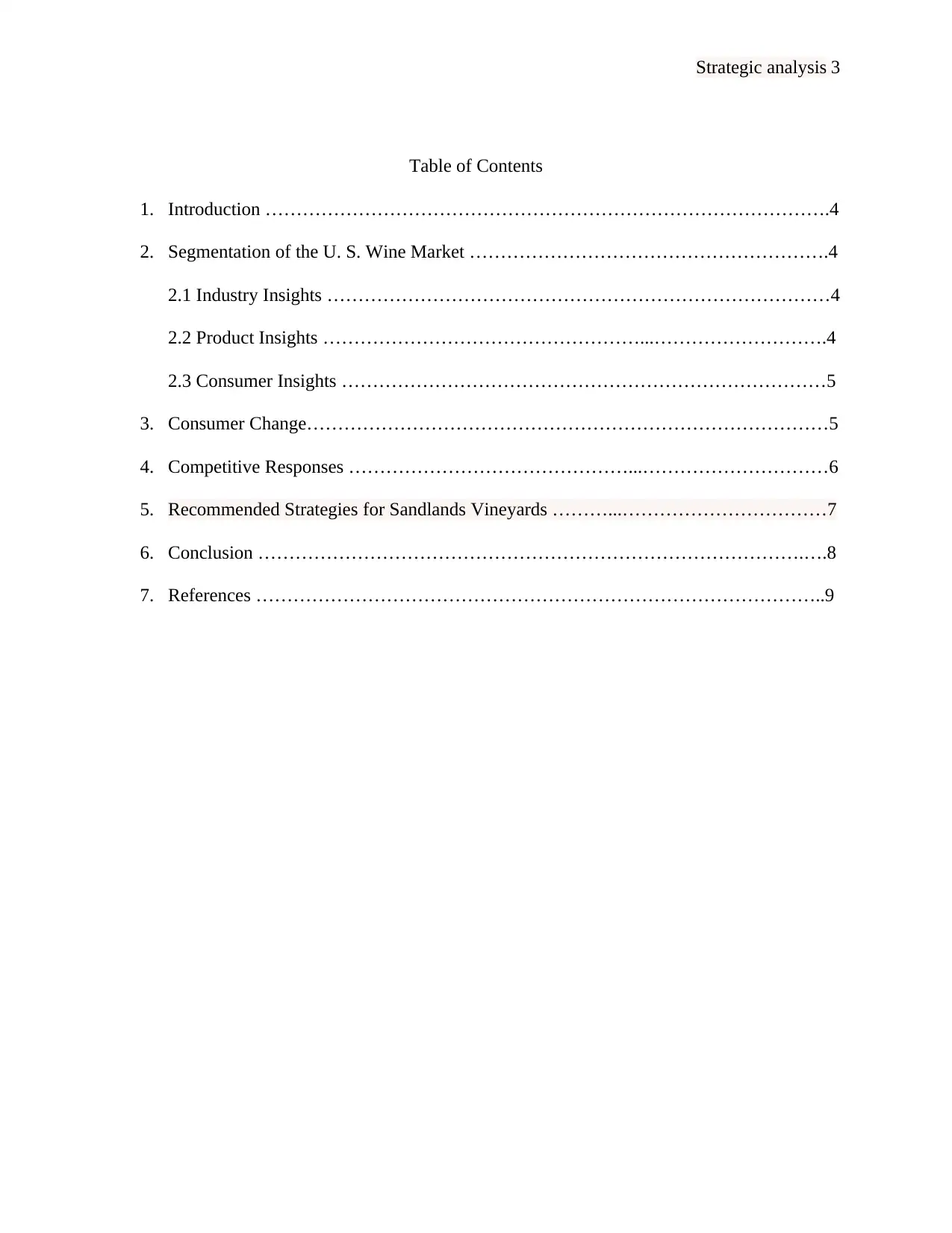
Strategic analysis 3
Table of Contents
1. Introduction ……………………………………………………………………………….4
2. Segmentation of the U. S. Wine Market ………………………………………………….4
2.1 Industry Insights ………………………………………………………………………4
2.2 Product Insights ……………………………………………...……………………….4
2.3 Consumer Insights ……………………………………………………………………5
3. Consumer Change…………………………………………………………………………5
4. Competitive Responses ………………………………………...…………………………6
5. Recommended Strategies for Sandlands Vineyards ………...……………………………7
6. Conclusion …………………………………………………………………………….….8
7. References ………………………………………………………………………………..9
Table of Contents
1. Introduction ……………………………………………………………………………….4
2. Segmentation of the U. S. Wine Market ………………………………………………….4
2.1 Industry Insights ………………………………………………………………………4
2.2 Product Insights ……………………………………………...……………………….4
2.3 Consumer Insights ……………………………………………………………………5
3. Consumer Change…………………………………………………………………………5
4. Competitive Responses ………………………………………...…………………………6
5. Recommended Strategies for Sandlands Vineyards ………...……………………………7
6. Conclusion …………………………………………………………………………….….8
7. References ………………………………………………………………………………..9
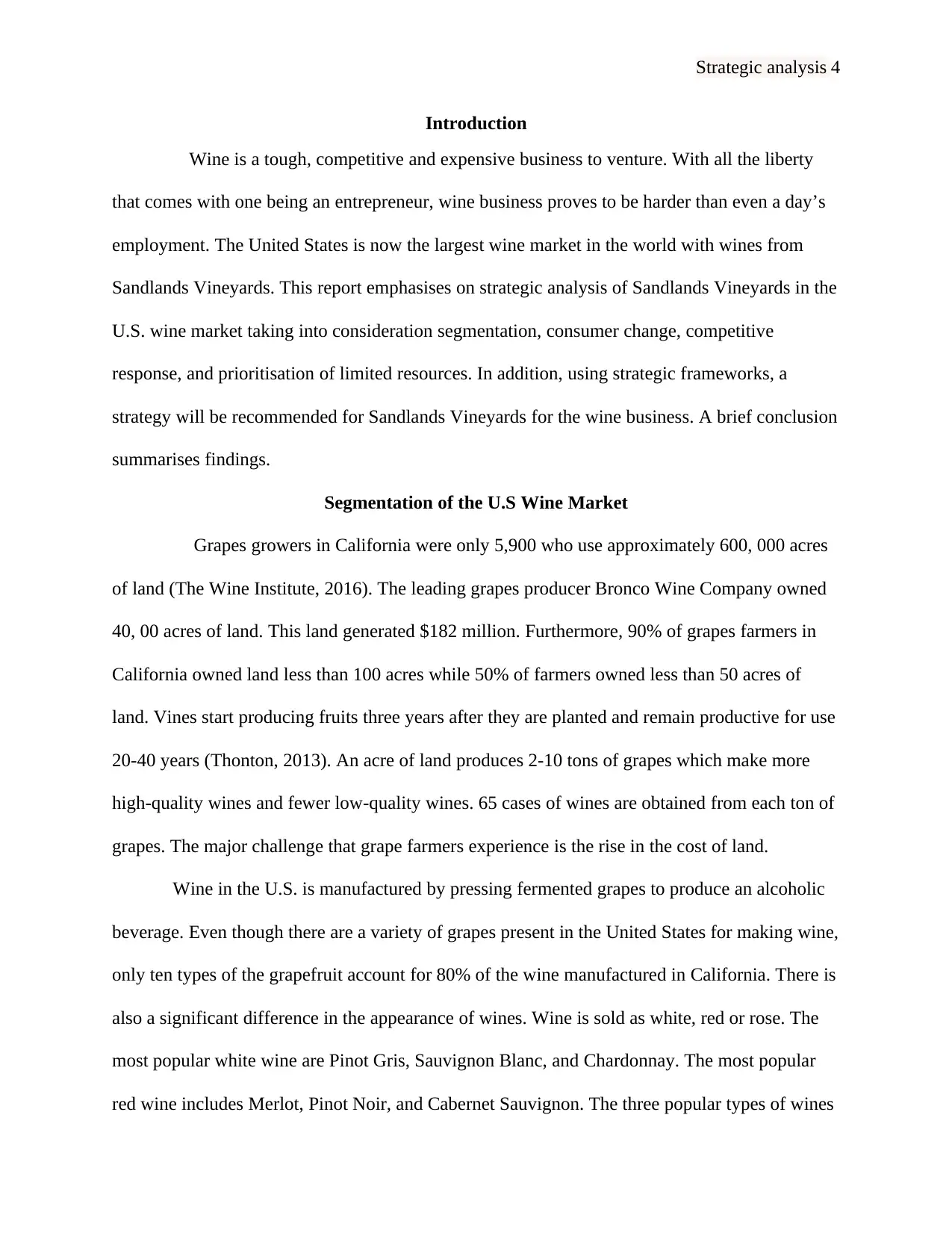
Strategic analysis 4
Introduction
Wine is a tough, competitive and expensive business to venture. With all the liberty
that comes with one being an entrepreneur, wine business proves to be harder than even a day’s
employment. The United States is now the largest wine market in the world with wines from
Sandlands Vineyards. This report emphasises on strategic analysis of Sandlands Vineyards in the
U.S. wine market taking into consideration segmentation, consumer change, competitive
response, and prioritisation of limited resources. In addition, using strategic frameworks, a
strategy will be recommended for Sandlands Vineyards for the wine business. A brief conclusion
summarises findings.
Segmentation of the U.S Wine Market
Grapes growers in California were only 5,900 who use approximately 600, 000 acres
of land (The Wine Institute, 2016). The leading grapes producer Bronco Wine Company owned
40, 00 acres of land. This land generated $182 million. Furthermore, 90% of grapes farmers in
California owned land less than 100 acres while 50% of farmers owned less than 50 acres of
land. Vines start producing fruits three years after they are planted and remain productive for use
20-40 years (Thonton, 2013). An acre of land produces 2-10 tons of grapes which make more
high-quality wines and fewer low-quality wines. 65 cases of wines are obtained from each ton of
grapes. The major challenge that grape farmers experience is the rise in the cost of land.
Wine in the U.S. is manufactured by pressing fermented grapes to produce an alcoholic
beverage. Even though there are a variety of grapes present in the United States for making wine,
only ten types of the grapefruit account for 80% of the wine manufactured in California. There is
also a significant difference in the appearance of wines. Wine is sold as white, red or rose. The
most popular white wine are Pinot Gris, Sauvignon Blanc, and Chardonnay. The most popular
red wine includes Merlot, Pinot Noir, and Cabernet Sauvignon. The three popular types of wines
Introduction
Wine is a tough, competitive and expensive business to venture. With all the liberty
that comes with one being an entrepreneur, wine business proves to be harder than even a day’s
employment. The United States is now the largest wine market in the world with wines from
Sandlands Vineyards. This report emphasises on strategic analysis of Sandlands Vineyards in the
U.S. wine market taking into consideration segmentation, consumer change, competitive
response, and prioritisation of limited resources. In addition, using strategic frameworks, a
strategy will be recommended for Sandlands Vineyards for the wine business. A brief conclusion
summarises findings.
Segmentation of the U.S Wine Market
Grapes growers in California were only 5,900 who use approximately 600, 000 acres
of land (The Wine Institute, 2016). The leading grapes producer Bronco Wine Company owned
40, 00 acres of land. This land generated $182 million. Furthermore, 90% of grapes farmers in
California owned land less than 100 acres while 50% of farmers owned less than 50 acres of
land. Vines start producing fruits three years after they are planted and remain productive for use
20-40 years (Thonton, 2013). An acre of land produces 2-10 tons of grapes which make more
high-quality wines and fewer low-quality wines. 65 cases of wines are obtained from each ton of
grapes. The major challenge that grape farmers experience is the rise in the cost of land.
Wine in the U.S. is manufactured by pressing fermented grapes to produce an alcoholic
beverage. Even though there are a variety of grapes present in the United States for making wine,
only ten types of the grapefruit account for 80% of the wine manufactured in California. There is
also a significant difference in the appearance of wines. Wine is sold as white, red or rose. The
most popular white wine are Pinot Gris, Sauvignon Blanc, and Chardonnay. The most popular
red wine includes Merlot, Pinot Noir, and Cabernet Sauvignon. The three popular types of wines
Secure Best Marks with AI Grader
Need help grading? Try our AI Grader for instant feedback on your assignments.
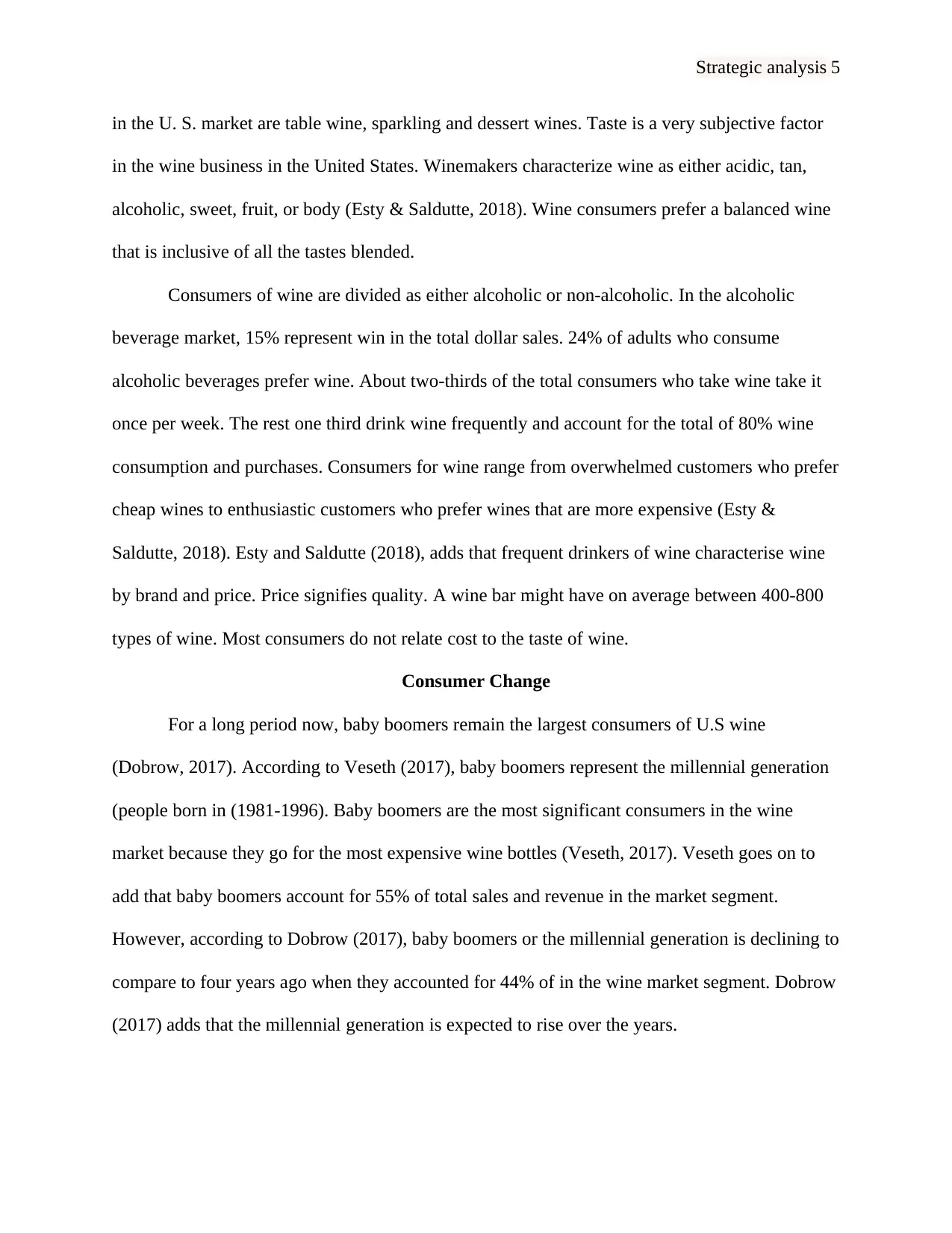
Strategic analysis 5
in the U. S. market are table wine, sparkling and dessert wines. Taste is a very subjective factor
in the wine business in the United States. Winemakers characterize wine as either acidic, tan,
alcoholic, sweet, fruit, or body (Esty & Saldutte, 2018). Wine consumers prefer a balanced wine
that is inclusive of all the tastes blended.
Consumers of wine are divided as either alcoholic or non-alcoholic. In the alcoholic
beverage market, 15% represent win in the total dollar sales. 24% of adults who consume
alcoholic beverages prefer wine. About two-thirds of the total consumers who take wine take it
once per week. The rest one third drink wine frequently and account for the total of 80% wine
consumption and purchases. Consumers for wine range from overwhelmed customers who prefer
cheap wines to enthusiastic customers who prefer wines that are more expensive (Esty &
Saldutte, 2018). Esty and Saldutte (2018), adds that frequent drinkers of wine characterise wine
by brand and price. Price signifies quality. A wine bar might have on average between 400-800
types of wine. Most consumers do not relate cost to the taste of wine.
Consumer Change
For a long period now, baby boomers remain the largest consumers of U.S wine
(Dobrow, 2017). According to Veseth (2017), baby boomers represent the millennial generation
(people born in (1981-1996). Baby boomers are the most significant consumers in the wine
market because they go for the most expensive wine bottles (Veseth, 2017). Veseth goes on to
add that baby boomers account for 55% of total sales and revenue in the market segment.
However, according to Dobrow (2017), baby boomers or the millennial generation is declining to
compare to four years ago when they accounted for 44% of in the wine market segment. Dobrow
(2017) adds that the millennial generation is expected to rise over the years.
in the U. S. market are table wine, sparkling and dessert wines. Taste is a very subjective factor
in the wine business in the United States. Winemakers characterize wine as either acidic, tan,
alcoholic, sweet, fruit, or body (Esty & Saldutte, 2018). Wine consumers prefer a balanced wine
that is inclusive of all the tastes blended.
Consumers of wine are divided as either alcoholic or non-alcoholic. In the alcoholic
beverage market, 15% represent win in the total dollar sales. 24% of adults who consume
alcoholic beverages prefer wine. About two-thirds of the total consumers who take wine take it
once per week. The rest one third drink wine frequently and account for the total of 80% wine
consumption and purchases. Consumers for wine range from overwhelmed customers who prefer
cheap wines to enthusiastic customers who prefer wines that are more expensive (Esty &
Saldutte, 2018). Esty and Saldutte (2018), adds that frequent drinkers of wine characterise wine
by brand and price. Price signifies quality. A wine bar might have on average between 400-800
types of wine. Most consumers do not relate cost to the taste of wine.
Consumer Change
For a long period now, baby boomers remain the largest consumers of U.S wine
(Dobrow, 2017). According to Veseth (2017), baby boomers represent the millennial generation
(people born in (1981-1996). Baby boomers are the most significant consumers in the wine
market because they go for the most expensive wine bottles (Veseth, 2017). Veseth goes on to
add that baby boomers account for 55% of total sales and revenue in the market segment.
However, according to Dobrow (2017), baby boomers or the millennial generation is declining to
compare to four years ago when they accounted for 44% of in the wine market segment. Dobrow
(2017) adds that the millennial generation is expected to rise over the years.
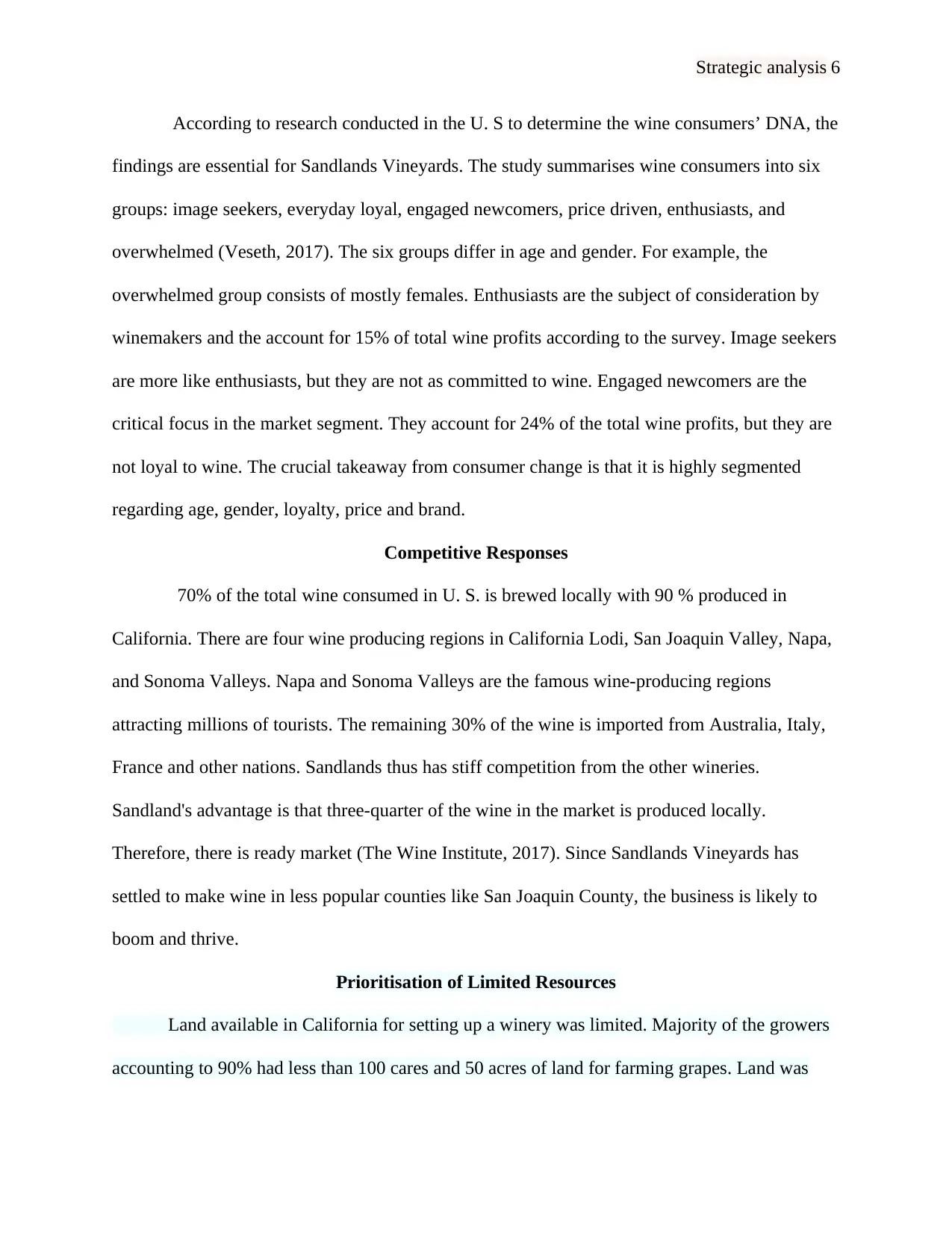
Strategic analysis 6
According to research conducted in the U. S to determine the wine consumers’ DNA, the
findings are essential for Sandlands Vineyards. The study summarises wine consumers into six
groups: image seekers, everyday loyal, engaged newcomers, price driven, enthusiasts, and
overwhelmed (Veseth, 2017). The six groups differ in age and gender. For example, the
overwhelmed group consists of mostly females. Enthusiasts are the subject of consideration by
winemakers and the account for 15% of total wine profits according to the survey. Image seekers
are more like enthusiasts, but they are not as committed to wine. Engaged newcomers are the
critical focus in the market segment. They account for 24% of the total wine profits, but they are
not loyal to wine. The crucial takeaway from consumer change is that it is highly segmented
regarding age, gender, loyalty, price and brand.
Competitive Responses
70% of the total wine consumed in U. S. is brewed locally with 90 % produced in
California. There are four wine producing regions in California Lodi, San Joaquin Valley, Napa,
and Sonoma Valleys. Napa and Sonoma Valleys are the famous wine-producing regions
attracting millions of tourists. The remaining 30% of the wine is imported from Australia, Italy,
France and other nations. Sandlands thus has stiff competition from the other wineries.
Sandland's advantage is that three-quarter of the wine in the market is produced locally.
Therefore, there is ready market (The Wine Institute, 2017). Since Sandlands Vineyards has
settled to make wine in less popular counties like San Joaquin County, the business is likely to
boom and thrive.
Prioritisation of Limited Resources
Land available in California for setting up a winery was limited. Majority of the growers
accounting to 90% had less than 100 cares and 50 acres of land for farming grapes. Land was
According to research conducted in the U. S to determine the wine consumers’ DNA, the
findings are essential for Sandlands Vineyards. The study summarises wine consumers into six
groups: image seekers, everyday loyal, engaged newcomers, price driven, enthusiasts, and
overwhelmed (Veseth, 2017). The six groups differ in age and gender. For example, the
overwhelmed group consists of mostly females. Enthusiasts are the subject of consideration by
winemakers and the account for 15% of total wine profits according to the survey. Image seekers
are more like enthusiasts, but they are not as committed to wine. Engaged newcomers are the
critical focus in the market segment. They account for 24% of the total wine profits, but they are
not loyal to wine. The crucial takeaway from consumer change is that it is highly segmented
regarding age, gender, loyalty, price and brand.
Competitive Responses
70% of the total wine consumed in U. S. is brewed locally with 90 % produced in
California. There are four wine producing regions in California Lodi, San Joaquin Valley, Napa,
and Sonoma Valleys. Napa and Sonoma Valleys are the famous wine-producing regions
attracting millions of tourists. The remaining 30% of the wine is imported from Australia, Italy,
France and other nations. Sandlands thus has stiff competition from the other wineries.
Sandland's advantage is that three-quarter of the wine in the market is produced locally.
Therefore, there is ready market (The Wine Institute, 2017). Since Sandlands Vineyards has
settled to make wine in less popular counties like San Joaquin County, the business is likely to
boom and thrive.
Prioritisation of Limited Resources
Land available in California for setting up a winery was limited. Majority of the growers
accounting to 90% had less than 100 cares and 50 acres of land for farming grapes. Land was
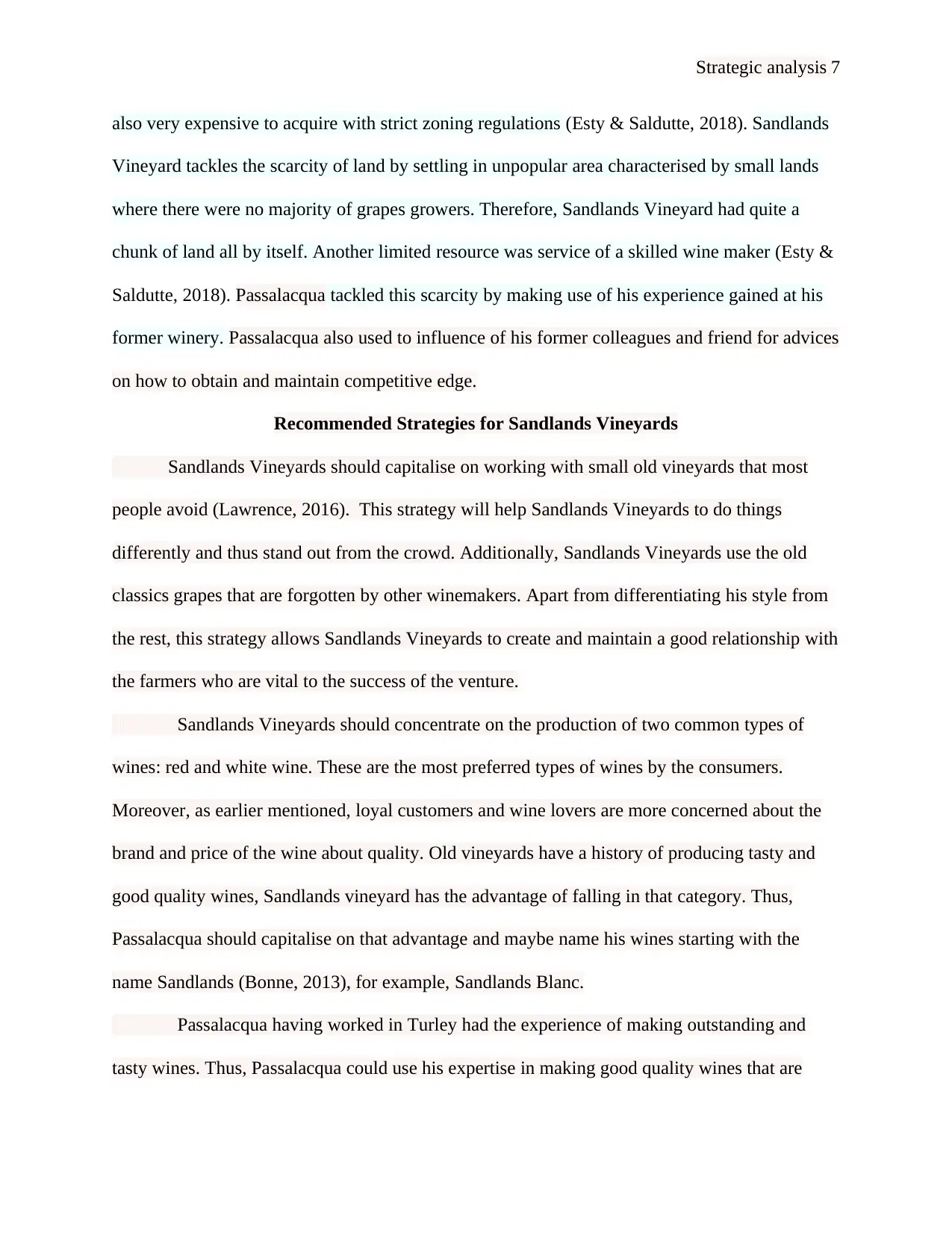
Strategic analysis 7
also very expensive to acquire with strict zoning regulations (Esty & Saldutte, 2018). Sandlands
Vineyard tackles the scarcity of land by settling in unpopular area characterised by small lands
where there were no majority of grapes growers. Therefore, Sandlands Vineyard had quite a
chunk of land all by itself. Another limited resource was service of a skilled wine maker (Esty &
Saldutte, 2018). Passalacqua tackled this scarcity by making use of his experience gained at his
former winery. Passalacqua also used to influence of his former colleagues and friend for advices
on how to obtain and maintain competitive edge.
Recommended Strategies for Sandlands Vineyards
Sandlands Vineyards should capitalise on working with small old vineyards that most
people avoid (Lawrence, 2016). This strategy will help Sandlands Vineyards to do things
differently and thus stand out from the crowd. Additionally, Sandlands Vineyards use the old
classics grapes that are forgotten by other winemakers. Apart from differentiating his style from
the rest, this strategy allows Sandlands Vineyards to create and maintain a good relationship with
the farmers who are vital to the success of the venture.
Sandlands Vineyards should concentrate on the production of two common types of
wines: red and white wine. These are the most preferred types of wines by the consumers.
Moreover, as earlier mentioned, loyal customers and wine lovers are more concerned about the
brand and price of the wine about quality. Old vineyards have a history of producing tasty and
good quality wines, Sandlands vineyard has the advantage of falling in that category. Thus,
Passalacqua should capitalise on that advantage and maybe name his wines starting with the
name Sandlands (Bonne, 2013), for example, Sandlands Blanc.
Passalacqua having worked in Turley had the experience of making outstanding and
tasty wines. Thus, Passalacqua could use his expertise in making good quality wines that are
also very expensive to acquire with strict zoning regulations (Esty & Saldutte, 2018). Sandlands
Vineyard tackles the scarcity of land by settling in unpopular area characterised by small lands
where there were no majority of grapes growers. Therefore, Sandlands Vineyard had quite a
chunk of land all by itself. Another limited resource was service of a skilled wine maker (Esty &
Saldutte, 2018). Passalacqua tackled this scarcity by making use of his experience gained at his
former winery. Passalacqua also used to influence of his former colleagues and friend for advices
on how to obtain and maintain competitive edge.
Recommended Strategies for Sandlands Vineyards
Sandlands Vineyards should capitalise on working with small old vineyards that most
people avoid (Lawrence, 2016). This strategy will help Sandlands Vineyards to do things
differently and thus stand out from the crowd. Additionally, Sandlands Vineyards use the old
classics grapes that are forgotten by other winemakers. Apart from differentiating his style from
the rest, this strategy allows Sandlands Vineyards to create and maintain a good relationship with
the farmers who are vital to the success of the venture.
Sandlands Vineyards should concentrate on the production of two common types of
wines: red and white wine. These are the most preferred types of wines by the consumers.
Moreover, as earlier mentioned, loyal customers and wine lovers are more concerned about the
brand and price of the wine about quality. Old vineyards have a history of producing tasty and
good quality wines, Sandlands vineyard has the advantage of falling in that category. Thus,
Passalacqua should capitalise on that advantage and maybe name his wines starting with the
name Sandlands (Bonne, 2013), for example, Sandlands Blanc.
Passalacqua having worked in Turley had the experience of making outstanding and
tasty wines. Thus, Passalacqua could use his expertise in making good quality wines that are
Paraphrase This Document
Need a fresh take? Get an instant paraphrase of this document with our AI Paraphraser
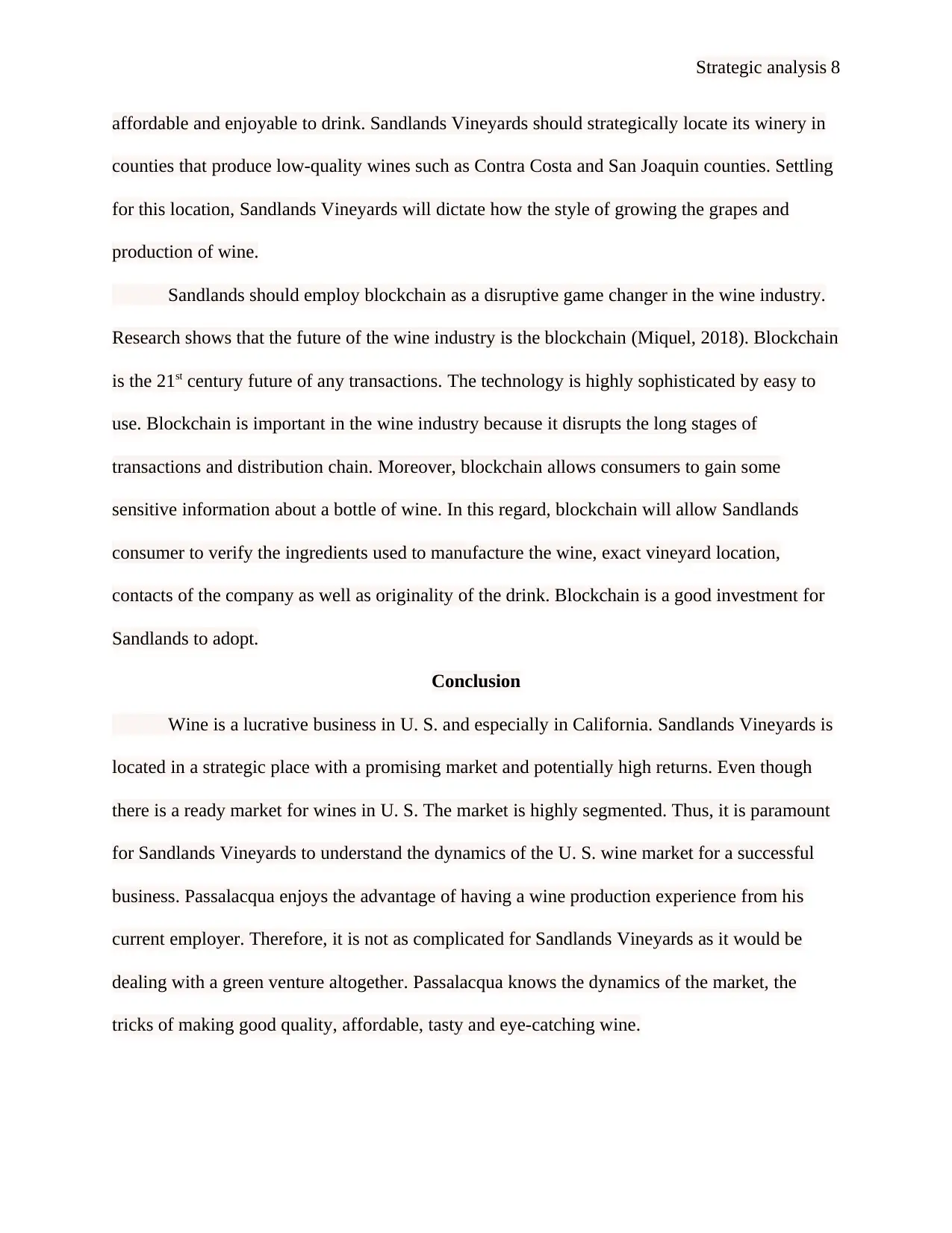
Strategic analysis 8
affordable and enjoyable to drink. Sandlands Vineyards should strategically locate its winery in
counties that produce low-quality wines such as Contra Costa and San Joaquin counties. Settling
for this location, Sandlands Vineyards will dictate how the style of growing the grapes and
production of wine.
Sandlands should employ blockchain as a disruptive game changer in the wine industry.
Research shows that the future of the wine industry is the blockchain (Miquel, 2018). Blockchain
is the 21st century future of any transactions. The technology is highly sophisticated by easy to
use. Blockchain is important in the wine industry because it disrupts the long stages of
transactions and distribution chain. Moreover, blockchain allows consumers to gain some
sensitive information about a bottle of wine. In this regard, blockchain will allow Sandlands
consumer to verify the ingredients used to manufacture the wine, exact vineyard location,
contacts of the company as well as originality of the drink. Blockchain is a good investment for
Sandlands to adopt.
Conclusion
Wine is a lucrative business in U. S. and especially in California. Sandlands Vineyards is
located in a strategic place with a promising market and potentially high returns. Even though
there is a ready market for wines in U. S. The market is highly segmented. Thus, it is paramount
for Sandlands Vineyards to understand the dynamics of the U. S. wine market for a successful
business. Passalacqua enjoys the advantage of having a wine production experience from his
current employer. Therefore, it is not as complicated for Sandlands Vineyards as it would be
dealing with a green venture altogether. Passalacqua knows the dynamics of the market, the
tricks of making good quality, affordable, tasty and eye-catching wine.
affordable and enjoyable to drink. Sandlands Vineyards should strategically locate its winery in
counties that produce low-quality wines such as Contra Costa and San Joaquin counties. Settling
for this location, Sandlands Vineyards will dictate how the style of growing the grapes and
production of wine.
Sandlands should employ blockchain as a disruptive game changer in the wine industry.
Research shows that the future of the wine industry is the blockchain (Miquel, 2018). Blockchain
is the 21st century future of any transactions. The technology is highly sophisticated by easy to
use. Blockchain is important in the wine industry because it disrupts the long stages of
transactions and distribution chain. Moreover, blockchain allows consumers to gain some
sensitive information about a bottle of wine. In this regard, blockchain will allow Sandlands
consumer to verify the ingredients used to manufacture the wine, exact vineyard location,
contacts of the company as well as originality of the drink. Blockchain is a good investment for
Sandlands to adopt.
Conclusion
Wine is a lucrative business in U. S. and especially in California. Sandlands Vineyards is
located in a strategic place with a promising market and potentially high returns. Even though
there is a ready market for wines in U. S. The market is highly segmented. Thus, it is paramount
for Sandlands Vineyards to understand the dynamics of the U. S. wine market for a successful
business. Passalacqua enjoys the advantage of having a wine production experience from his
current employer. Therefore, it is not as complicated for Sandlands Vineyards as it would be
dealing with a green venture altogether. Passalacqua knows the dynamics of the market, the
tricks of making good quality, affordable, tasty and eye-catching wine.
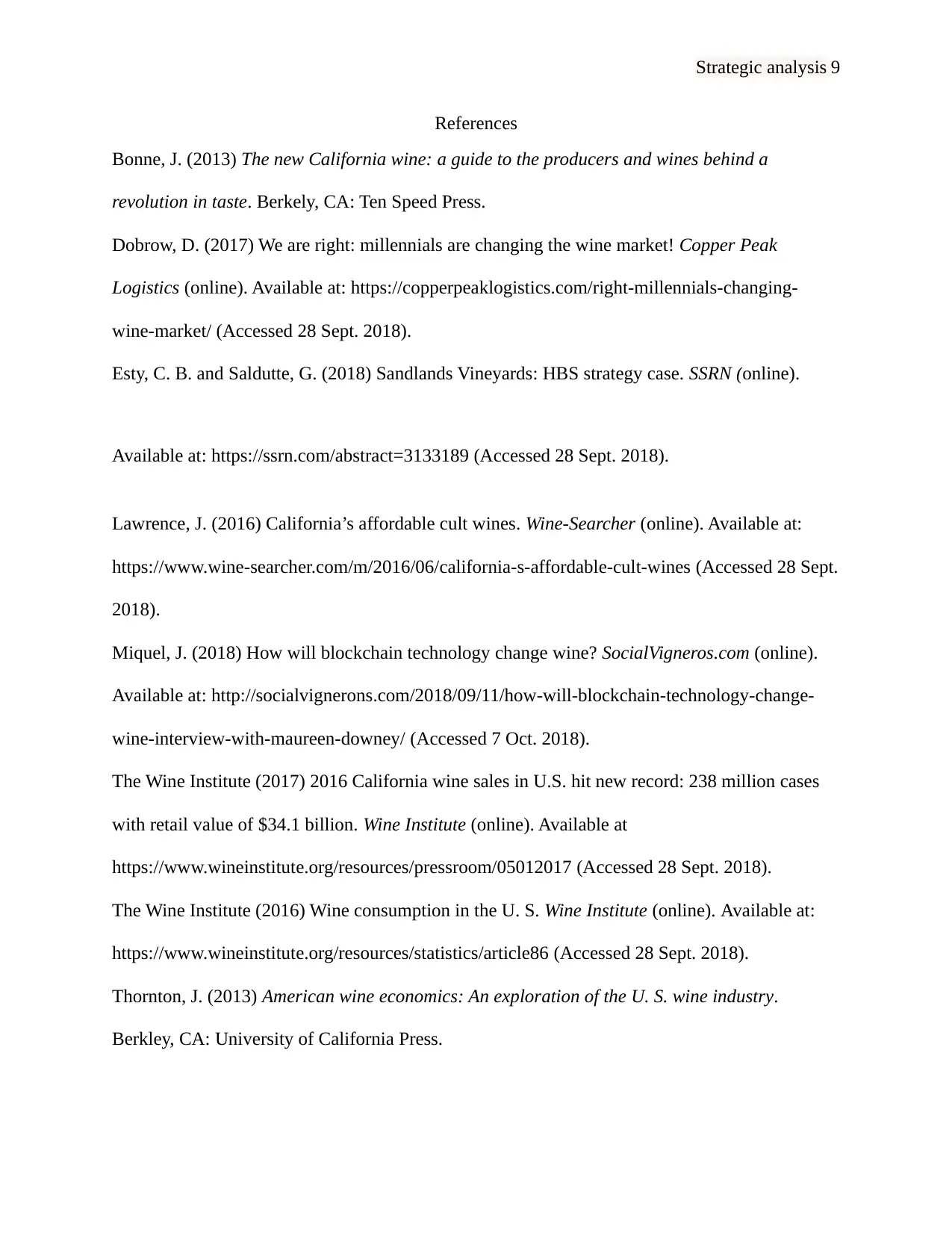
Strategic analysis 9
References
Bonne, J. (2013) The new California wine: a guide to the producers and wines behind a
revolution in taste. Berkely, CA: Ten Speed Press.
Dobrow, D. (2017) We are right: millennials are changing the wine market! Copper Peak
Logistics (online). Available at: https://copperpeaklogistics.com/right-millennials-changing-
wine-market/ (Accessed 28 Sept. 2018).
Esty, C. B. and Saldutte, G. (2018) Sandlands Vineyards: HBS strategy case. SSRN (online).
Available at: https://ssrn.com/abstract=3133189 (Accessed 28 Sept. 2018).
Lawrence, J. (2016) California’s affordable cult wines. Wine-Searcher (online). Available at:
https://www.wine-searcher.com/m/2016/06/california-s-affordable-cult-wines (Accessed 28 Sept.
2018).
Miquel, J. (2018) How will blockchain technology change wine? SocialVigneros.com (online).
Available at: http://socialvignerons.com/2018/09/11/how-will-blockchain-technology-change-
wine-interview-with-maureen-downey/ (Accessed 7 Oct. 2018).
The Wine Institute (2017) 2016 California wine sales in U.S. hit new record: 238 million cases
with retail value of $34.1 billion. Wine Institute (online). Available at
https://www.wineinstitute.org/resources/pressroom/05012017 (Accessed 28 Sept. 2018).
The Wine Institute (2016) Wine consumption in the U. S. Wine Institute (online). Available at:
https://www.wineinstitute.org/resources/statistics/article86 (Accessed 28 Sept. 2018).
Thornton, J. (2013) American wine economics: An exploration of the U. S. wine industry.
Berkley, CA: University of California Press.
References
Bonne, J. (2013) The new California wine: a guide to the producers and wines behind a
revolution in taste. Berkely, CA: Ten Speed Press.
Dobrow, D. (2017) We are right: millennials are changing the wine market! Copper Peak
Logistics (online). Available at: https://copperpeaklogistics.com/right-millennials-changing-
wine-market/ (Accessed 28 Sept. 2018).
Esty, C. B. and Saldutte, G. (2018) Sandlands Vineyards: HBS strategy case. SSRN (online).
Available at: https://ssrn.com/abstract=3133189 (Accessed 28 Sept. 2018).
Lawrence, J. (2016) California’s affordable cult wines. Wine-Searcher (online). Available at:
https://www.wine-searcher.com/m/2016/06/california-s-affordable-cult-wines (Accessed 28 Sept.
2018).
Miquel, J. (2018) How will blockchain technology change wine? SocialVigneros.com (online).
Available at: http://socialvignerons.com/2018/09/11/how-will-blockchain-technology-change-
wine-interview-with-maureen-downey/ (Accessed 7 Oct. 2018).
The Wine Institute (2017) 2016 California wine sales in U.S. hit new record: 238 million cases
with retail value of $34.1 billion. Wine Institute (online). Available at
https://www.wineinstitute.org/resources/pressroom/05012017 (Accessed 28 Sept. 2018).
The Wine Institute (2016) Wine consumption in the U. S. Wine Institute (online). Available at:
https://www.wineinstitute.org/resources/statistics/article86 (Accessed 28 Sept. 2018).
Thornton, J. (2013) American wine economics: An exploration of the U. S. wine industry.
Berkley, CA: University of California Press.
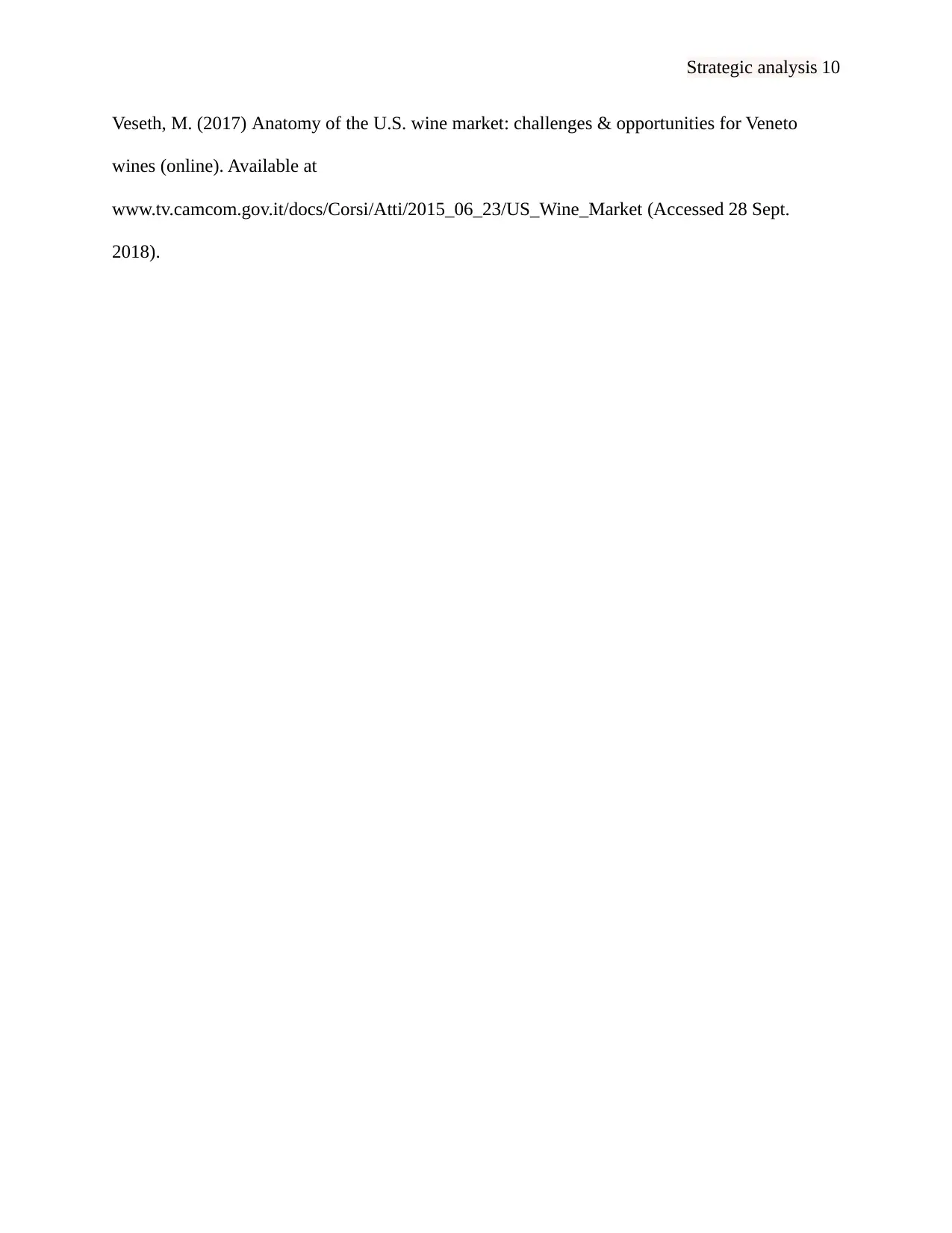
Strategic analysis 10
Veseth, M. (2017) Anatomy of the U.S. wine market: challenges & opportunities for Veneto
wines (online). Available at
www.tv.camcom.gov.it/docs/Corsi/Atti/2015_06_23/US_Wine_Market (Accessed 28 Sept.
2018).
Veseth, M. (2017) Anatomy of the U.S. wine market: challenges & opportunities for Veneto
wines (online). Available at
www.tv.camcom.gov.it/docs/Corsi/Atti/2015_06_23/US_Wine_Market (Accessed 28 Sept.
2018).
1 out of 10
Your All-in-One AI-Powered Toolkit for Academic Success.
+13062052269
info@desklib.com
Available 24*7 on WhatsApp / Email
![[object Object]](/_next/static/media/star-bottom.7253800d.svg)
Unlock your academic potential
© 2024 | Zucol Services PVT LTD | All rights reserved.


